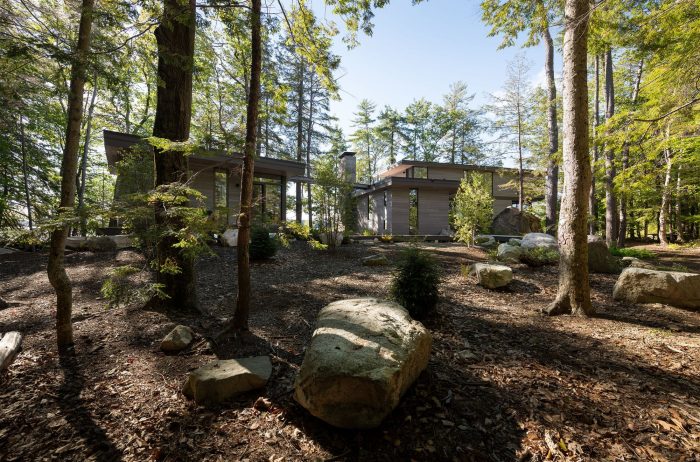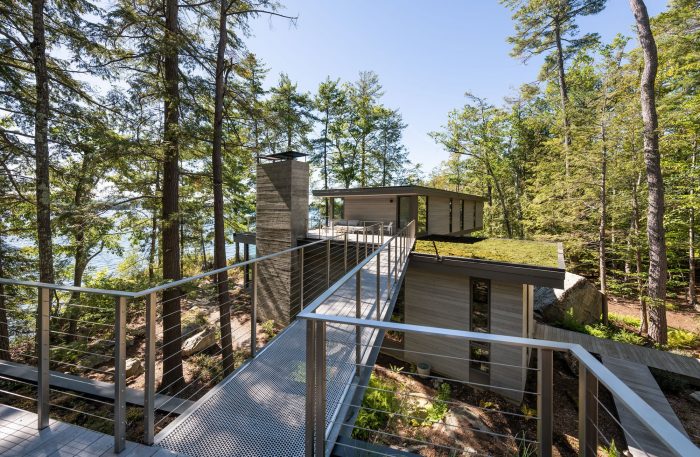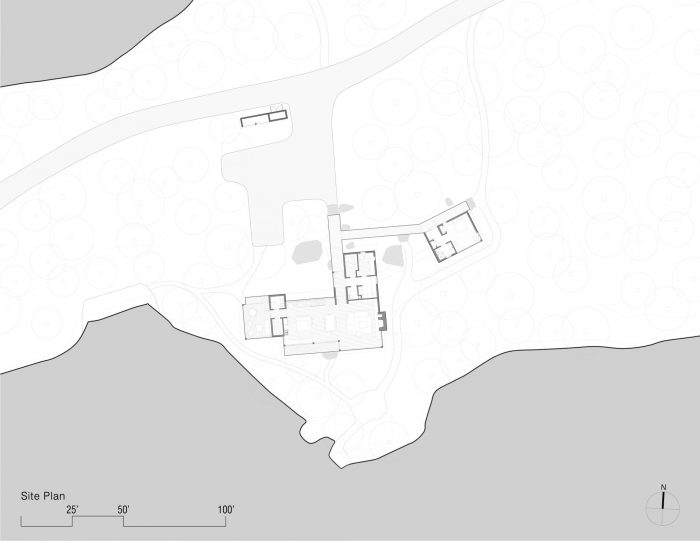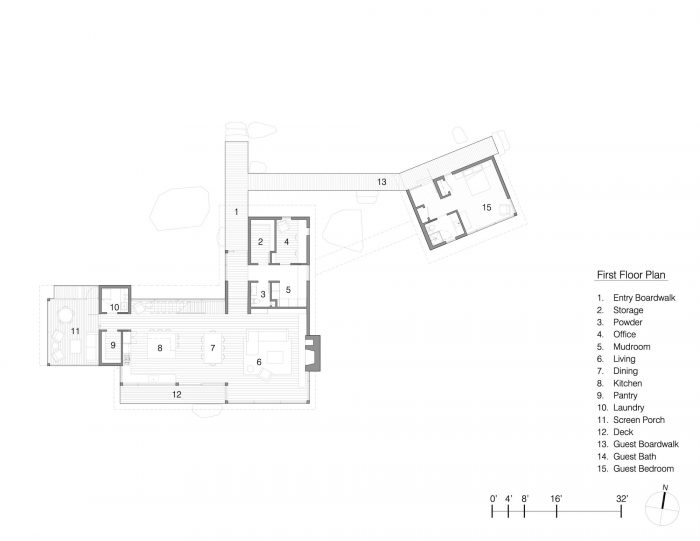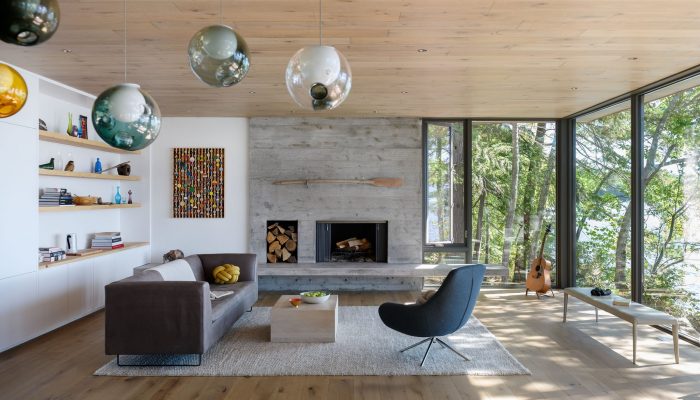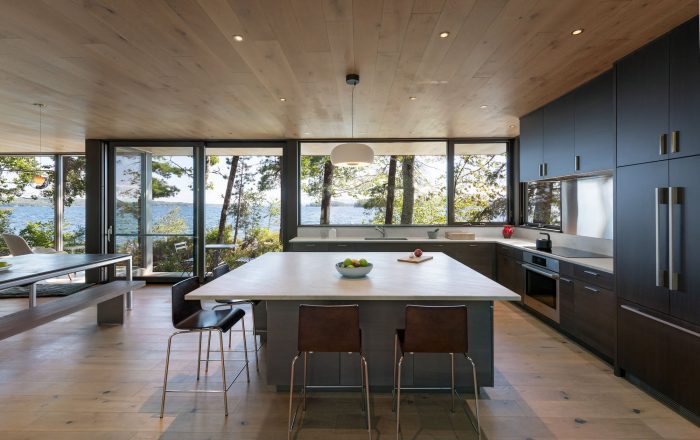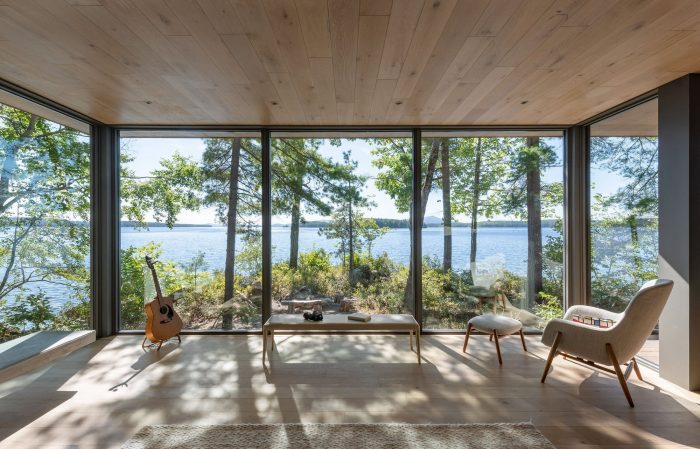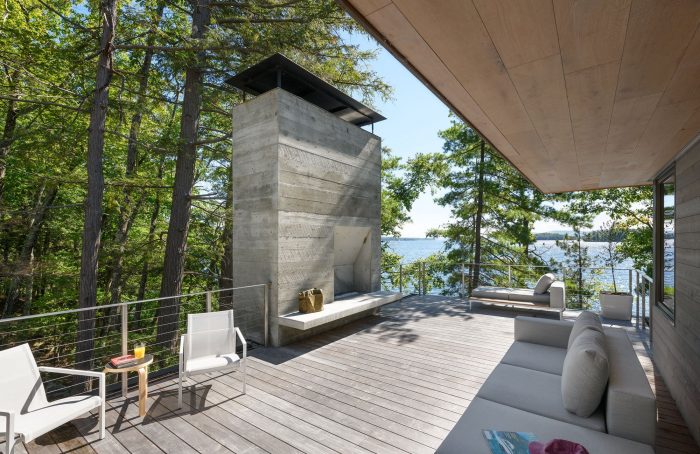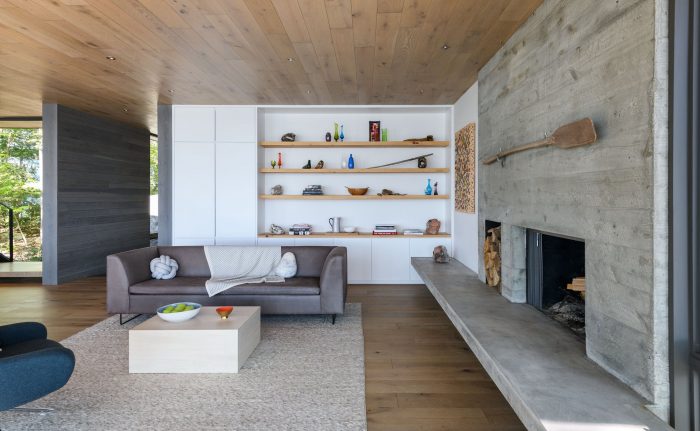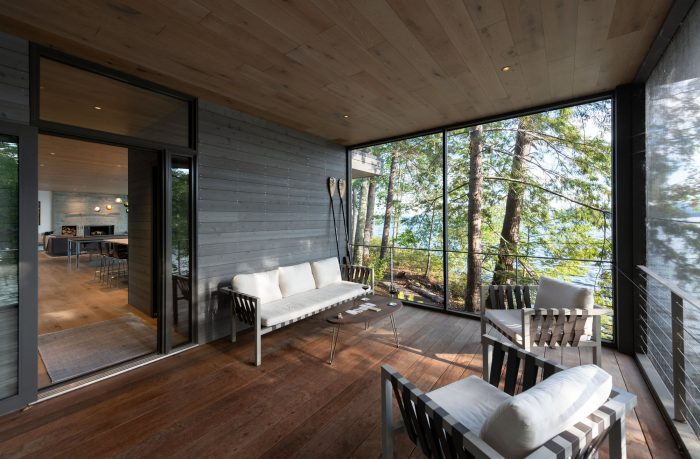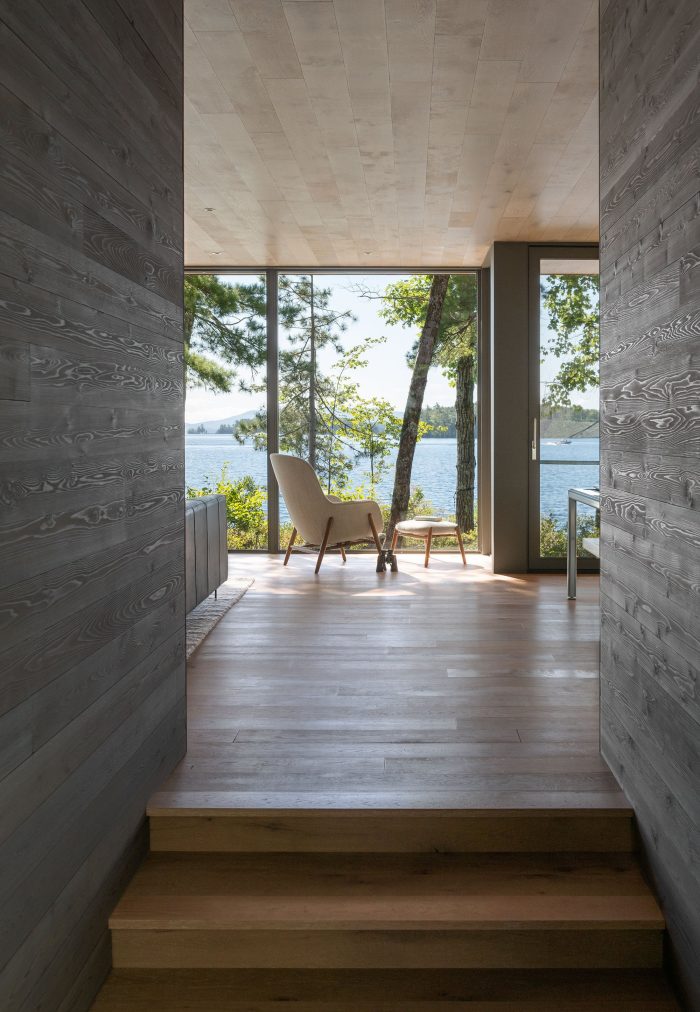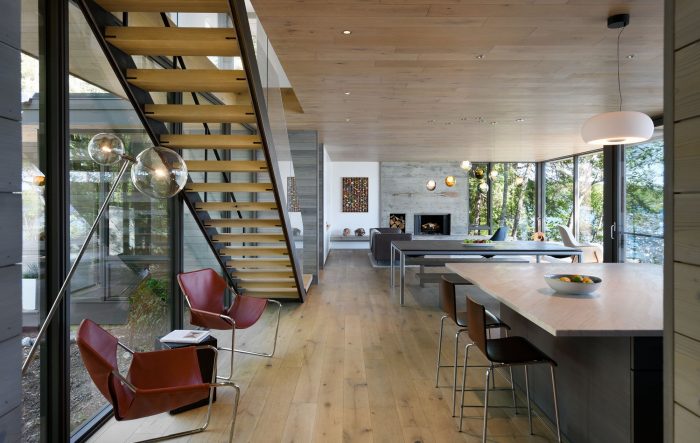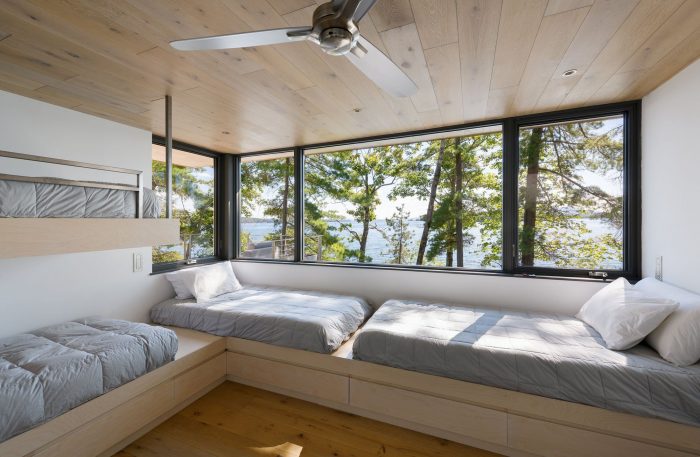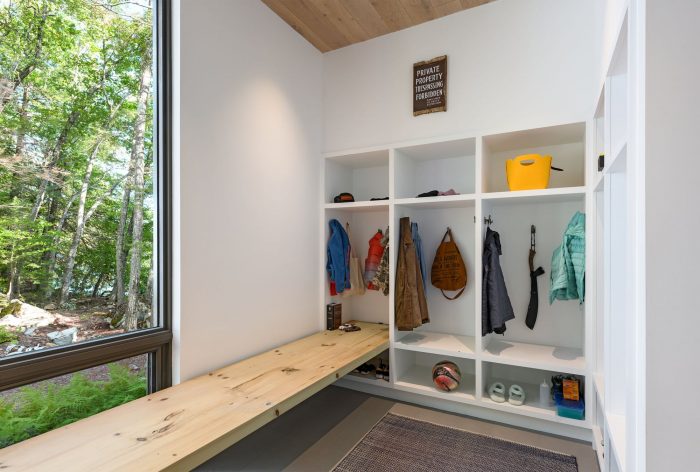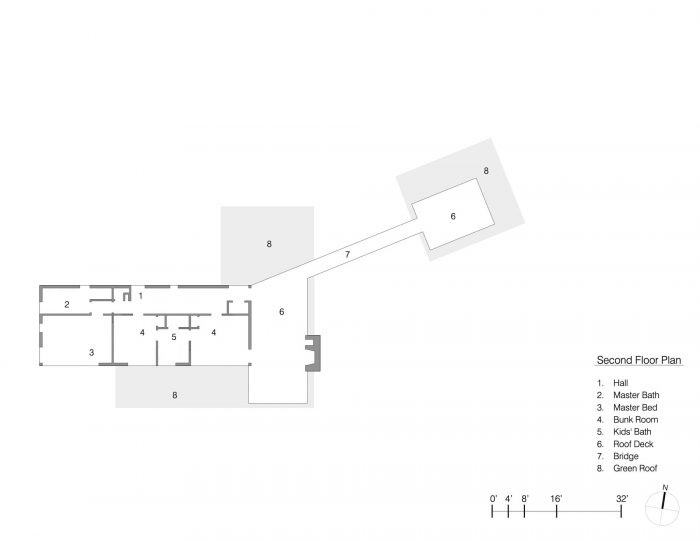高架营地是一个五口之家的四季湖边度假胜地,由一个2733平方米的住宅和一个382平方米的客舱组成,通过高架木板路连接。营地位于以前的小木屋的脚印上,允许新的设计利用祖父的脚印(根据当地法规要求),并限制从现场清除树木。 客户要求营地是亲密和私密的,以便家人相互享受,但也要向场地开放,以便积极地参与和享受周围的自然环境。
The Elevated Camp is a four-season lakeside retreat for a family of five and is comprised of a 2,733 s.f. residence and a 382 s.f. guest cabin, linked via an elevated boardwalk. The camp is located on the footprint of a prior cabin, allowing the new design to utilize the grandfathered footprint (required by local regulations) and limit the clearing of trees from the site. The clients requested that the camp be intimate and private for the family to enjoy one another, but also open to the site to actively engage and enjoy the natural surroundings.
设计最大限度地减少了对景观的影响,并通过保留和编织其各种特征来赞美自然场地的特征;南边的相邻海岸线,北边的不朽的冰川侵蚀巨石,盘旋在森林地面和散落的巨石之上,并在森林的铁杉和松树中穿梭。
The design minimizes impact on the landscape and celebrates the natural site’s character by preserving and weaving through its various features; the adjacent shoreline on the south, a monumental glacial erratic boulder to the north, hovering above the forest floor and scattered boulders, and navigating the forest’s hemlock and pine trees.
从概念上讲,房子被设想为一个私人/半私人空间的安排,被分组为固体块。这些区块被安排成框架,并容纳家庭室的公共开放空间。家庭室是房子的枢纽,被安排为外部的一部分–可以看到南部的湖泊全景。 在接近房子的入口时,建筑动态地环绕着冰川侵蚀,框住了开放的家庭室,并创造了一个朝向湖面的开孔,邀请人们进入房子。
Conceptually, the house is conceived as an arrangement of private / semi-private spaces grouped as solid blocks. These blocks are arranged to frame and hold the common open space of the family room. The family room is the nexus of the house and is organized as part of the exterior – with southern panoramic views of the lake. On approaching the entrance of the house, the building dynamically wraps around the glacial erratic, framing the open family room and creating an aperture with views beyond towards the lake, inviting one into the house.
营地的私人空间是私密的,在视觉上是安静的,并使用战略性的窗户来框定特定的场地条件。 例如,主卧室被悬挑在湖面上的树冠上,提供了一个戏剧性的湖面俯瞰。 卧室被树木遮挡,以保护隐私,但阳光穿透树叶,用闪烁的斑驳阳光和投射的阴影激活了空间。
The camp’s private spaces are intimate, and visually quiet, and use strategically placed windows to frame specific site conditions. For instance, the master bedroom is cantilevered into the tree canopy above the lake, providing a dramatic overlook of the lake. A veil of trees screens the bedroom for privacy but sunlight penetrates the foliage of the trees, activating the space with flickering dappled sunlight and cast shadows.
营地通过一个由高架木板路、楼梯、平台和桥梁组成的循环网络进行导航。随着人们的循环,一个编排好的经验逐渐显示出景观特征和战略观点。多个外部生活空间利用了不同的条件和景观;一个带有户外壁炉和湖景的屋顶平台,一个俯瞰水边的屏风门廊,一个通过悬空钢桥进入的儿童屋顶平台,以及其他空间。
The camp is navigated via a circulation network of elevated boardwalks, stairs, decks, and a bridge. As one circulates a choreographed experience progressively reveals landscape features and strategic views. Multiple exterior living spaces take advantage of varied conditions and views; a roof deck with outdoor fireplace and lake views, a screened porch overlooking the water’s edge, a kids rooftop deck accessed via a suspended steel bridge, as well as other spaces.
营地的材料调色板是克制和柔和的。外部的中性灰色护墙板、混凝土和钢材在视觉上退缩到灰色树干和风化的巨石的阴影中。外部材料在关键的过渡处贯穿到内部,模糊了内部和外部的界限。室内的中性色调突出了景观中的树叶、水和天空的丰富和动态色彩。
The material palette of the camp is restrained and muted. The exterior neutral grey siding, concrete, and steel visually recede into the shaded landscape of textured grey tree trunks and weathered boulders. Exterior materials carry through to the interior at critical transitions, blurring the interior and exterior boundaries. The interior’s neutral palette highlights and foregrounds the rich and dynamic coloration of the landscape’s foliage, water, and sky.
总的来说,该建筑在与景观的对话中表现出一种动态的姿态,轻轻地触碰土地,拥抱亲密的室内空间,让家人可以聚集在一起,享受外面的风景。没有安装空调。该建筑使用了超出规范的绝缘材料、地板辐射采暖和被动冷却策略,包括交叉通风、树木遮阳和使用吊扇。除了已经提到的景观保护策略外,所有的景观设计都没有灌溉。
Overall, the building strikes a dynamic gesture in dialogue with the landscape, touching the land lightly and embracing intimate interiors where the family can convene and enjoy the landscape beyond. No air conditioning was installed. The building uses code exceeding insulation, radiant floor heating, and passive cooling strategies including cross-ventilation, tree shading, and the use of ceiling fans. Beyond landscape conservation strategies already noted, all landscaping was designed without irrigation.
Architects: Murdough Design Architects
Year : 2020
Photographs :Chuck Choi Architectural Photography
Manufacturers : Lepage Millwork, reSAWN TIMBER co.
Lead Architects : Thomas Murdough
Contractor : Denali Construction – Jim DePaolo
Landscape Contractor : Miracle Farms – Chris Maroun
Structural Engineer : RSE Associates – Richmond So
Design/Architecture : Jenny Tjia, Rob Potish, Ben Tulman
Surveyor : T.F. Bernier Inc. – Tim Bernier
Country : United States


